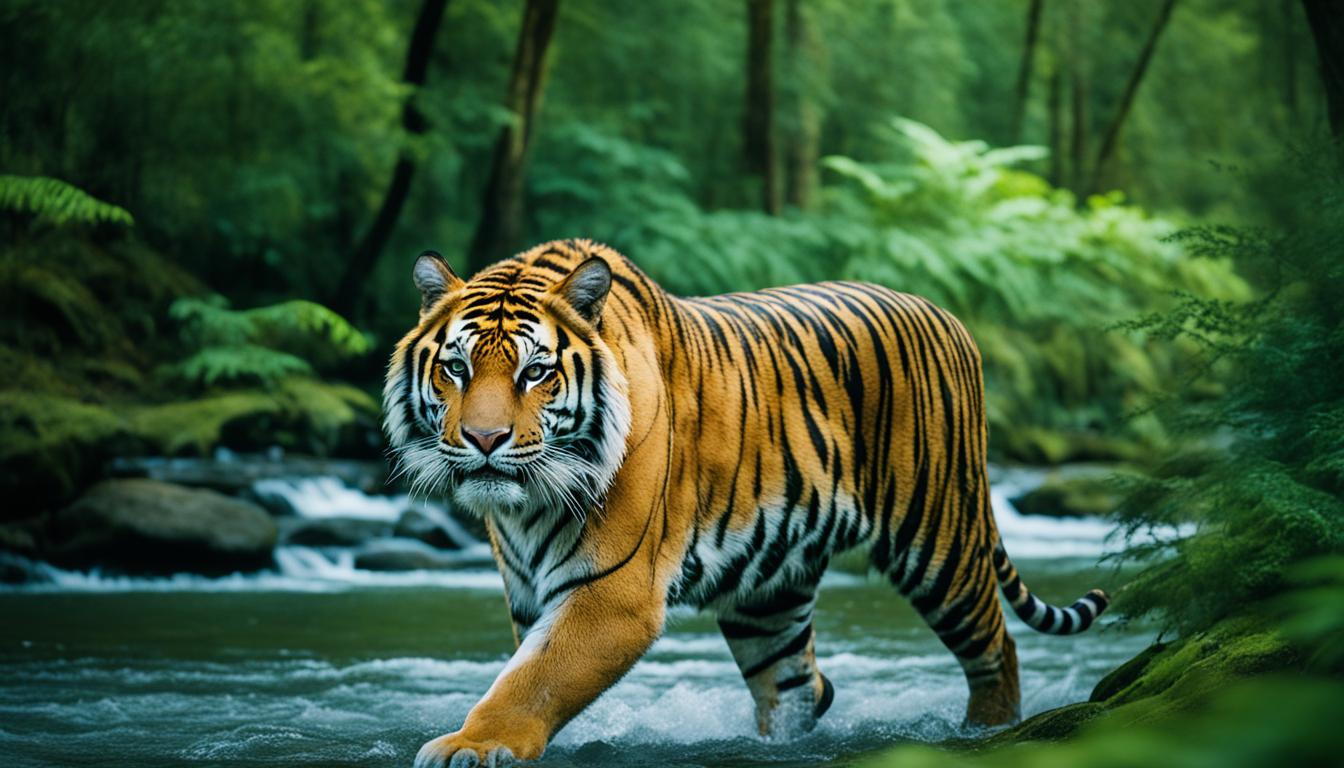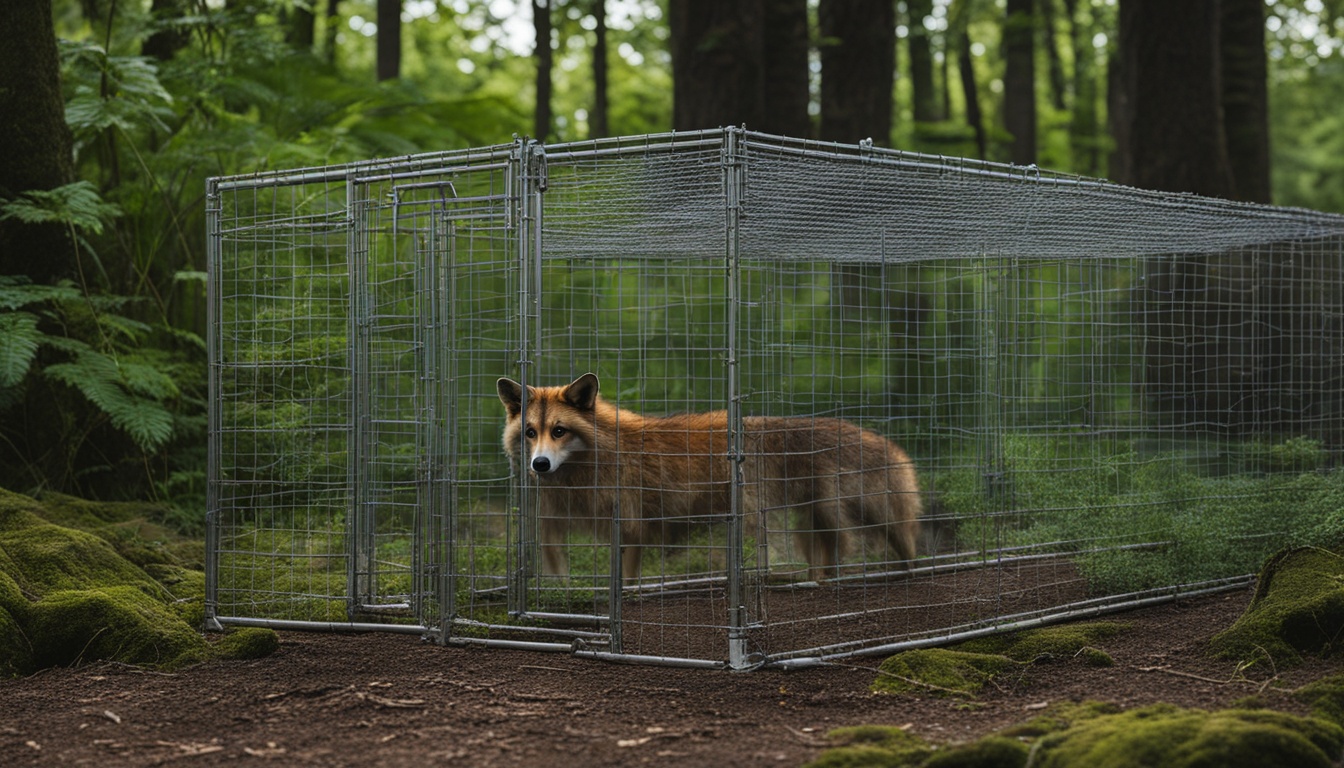Have you ever thought about wild tigers in America? There’s over 10,000 tigers held in captivity all over the country. It’s possible some could be living in the wild. But, is there a real wild tiger population in America?
In the U.S., some captive tigers have escaped into nature. One case was in 2017, when a Bengal tiger cub was brought illegally across the US-Mexico border. However, there are no known wild tiger populations in America. This is true for any big cat habitats here.
Introduction to the Status of Wild Tigers in the USA
The status of United States tigers is a reflection of complex issues including wildlife trafficking, ownership legality, and conservation efforts. Despite reports of tiger sightings, these magnificent creatures are not native to the USA. Usually, any presence of tigers in the wild is due to escape or release from captivity.
Conservationists are worried about the endangered tigers in America. Many cases show these tigers have been trafficked or are in private hands. This is very risky for the tigers and makes their protection harder.
It’s important to know tiger ownership laws in the USA. The different rules in each state make it hard to protect tigers well. The mix of federal and state laws makes a unique challenge for people working to save these tigers.
History of Tigers in the United States
The story of tigers in the United States is tied to worldwide trading and changing views on keeping exotic animals. We’ll explore how these amazing creatures came to the U.S.
Early Importation of Tigers
Tigers arrived in the U.S. long ago, mostly for private collections and zoos. The wealthy and institutions wanted these unique animals for their properties and displays. This started the era of having wild tiger species in the United States, but they were in a controlled setting.
Growth of the Captive Tiger Population
As time went on, more and more tigers were kept in the United States. Looser laws and the need for tiger parts in Chinese medicine helped this increase. These elements aided in the captive tiger population growth, which is now believed to be at 10,000 tigers.
Today, many of these tigers live in private collections, animal sanctuaries, and reputable zoos. This has heavily influenced how exotic animals are taken care of in the U.S.
Tiger Ownership Laws in the USA
In the United States, laws on owning tigers change a lot from place to place. These rules can get pretty detailed. They mix both state and national laws together.
Federal Regulations
When it comes to owning tigers, the federal government looks at two key laws. These are the Endangered Species Act (ESA) and the Animal Welfare Act (AWA). The ESA helps protect tigers, making it illegal to harm them in the country. The AWA, run by the USDA, sets standard care practices for captive tigers.
Some might be allowed to own tigers for “conservation” but they must follow these federal laws.
State-by-State Regulations
Each state has its own take on tiger ownership. Some places have tough rules, others are more relaxed, and a few have no rules at all.
It’s important to compare state laws to really understand the differences. This helps you know what’s expected if you’re thinking about owning a tiger privately.
| State | Regulation | Permit Requirement |
|---|---|---|
| California | Strict Ban | No Permits Issued |
| Texas | Minimal Regulation | USDA License Required |
| Nevada | No State Laws | No Permits Required |
Knowing the State-by-State Tiger Regulations is crucial if you want to own a tiger. You’ve got to deal with both federal and state laws. It can be confusing, but following these laws is important for both your and the tiger’s well-being.
Status of Captive Tigers in the USA
The captive tiger status in the USA brings up big welfare and ethical worries. Many tigers suffer due to big cat mistreatment and exploitation. They’re used in money-making attractions like private shows and photo ops. This way, their well-being and true conservation value get questioned.
The desire for tiger cubs as photo props keeps rising in private hands. This trend makes big cat mistreatment and exploitation worse. It gives these tigers a bad life. Exploring how these tigers are treated and used is key to see the whole picture.
| Aspect | Observations |
|---|---|
| Use in Attractions | Tigers often used in private shows and as photo props are very common |
| Welfare Concerns | Many reports mention awful living conditions and mistreatment |
| Conservation Value | Has been low due to exploitation and lack of proper care |
Seeing the captive tiger status means also seeing all the big cat mistreatment and exploitation. It’s crucial to deal with these problems. Only then can the tigers’ well-being improve, and real conservation happen.
Wild Tiger Sightings in America
When we hear of wild tiger sightings in America, it can surprise us. However, these sightings are not from a native population. They are usually linked to tigers escaping from human captivity. This is important to keep in mind when hearing these stories.
Incidents of Escaped Tigers
There are many cases of tigers breaking free from living in captivity. One notable event occurred in 2021 in Houston, Texas. A tiger escaped from a home and was later seen in a neighborhood. Local officials manage these situations quickly. Nevertheless, the aftereffects of such cases create stories of wild tigers in the country.
Misconceptions About Wild Tigers in the USA
It’s often assumed that there are native, wild tigers in the United States. Yet, most of the tales of wild tigers are due to tigers escaping captivity. These stories lead to myths. In truth, wild tigers are not part of the American environment.
United States Tiger Conservation Efforts
In the United States, efforts to save tigers come from many places. These include various groups and projects. Their goal is to tackle the problems from illegal wildlife trade and care for tigers in captivity. But, the struggle continues, with many saying that too many tigers kept in cages is harming the wild tiger populations globally.
Organizations and Initiatives
The World Wildlife Fund (WWF) and Panthera are key players in these efforts. They work to make people aware, help fund research, and stop poaching around the world. Panthera, for instance, teams up with others globally to make sure tiger conservation is done well and with tiger-friendly rules.
Important work is also happening through new laws in the U.S., like the Big Cat Public Safety Act. This act looks to control who can own and breed tigers. It’s a big step towards fixing how we take care of and use captive tigers.
Impact on Global Tiger Populations
While the U.S. is working hard to help tigers, the issue of too many tigers in captivity is still big. Some think that these many captive tigers aren’t really helping the tigers in the wild. This is because not all captive tigers are managed in a way that truly helps wild tiger numbers grow.
There’s a big talk about how U.S. efforts might not always be good for wild tigers worldwide. So, matching our efforts with what the whole world is doing is crucial for making a real uplift for tigers everywhere.
| Organization | Focus Areas | Notable Projects |
|---|---|---|
| World Wildlife Fund (WWF) | Anti-poaching, habitat protection | TX2 Goal (doubling wild tigers by 2022) |
| Panthera | Research, advocacy | Tiger Corridor Initiative |
| Big Cat Rescue | Sanctuary services, public education | Big Cat Public Safety Act |
Challenges Faced by Captive Tigers
Captive tigers often live in environments that don’t meet their needs. They deal with captive tiger challenges like poor living conditions, little space, and bad nutrition. This can lead to serious health problems. T hey get stressed and may act out because they don’t have enough room. Also, they aren’t getting the right food.
Many tigers are cared for by private owners or in places that don’t look after them well. They don’t get enough space or things to do, which hurts both their bodies and minds. Without enough to eat or see a vet, they get sick and don’t live as long as they should.
Being in captivity also affects tigers emotionally. Without the challenges of the wild, they often start doing repetitive things like walking the same path over and over or hurting themselves. Not being able to hunt or have a normal tiger family makes their situation even worse.
| Challenges | Impacts | Solutions |
|---|---|---|
| Inadequate Living Conditions | Stress and Behavioral Problems | Larger Enclosures and Enrichment |
| Poor Nutrition | Health Issues and Malnutrition | Proper Diet and Regular Veterinary Care |
| Lack of Mental Stimulation | Stereotypic Behaviors | Environmental Enrichment and Social Interaction |
Legal and Ethical Implications
Having tigers as pets raises big questions about the law and what’s right. It might be cool to think about owning one, but we must look closely at the issues. Many problems are linked to letting people own tigers. Because of this, there’s a push for laws that would keep both the cats and people safe.
Arguments Against Private Ownership
One key issue is safety for everyone. Tigers are not like other pets; they are wild, strong hunters. When kept in homes, they can put owners, their families, and others at risk. There have been cases where tigers got out and hurt or even killed people. This is a major concern for those against having tigers as pets.
There’s also the matter of how well the tigers are cared for. They need a lot of space, the right social setup, and special care. But many private owners can’t meet these needs. This leads to the tigers being unhappy and sick. Such situations raise big ethical questions about if it’s right to keep these wild animals in captivity.
Proposed Reforms and Legislation
People are working hard to address these worries. Laws are being suggested to stop private tiger ownership. The Big Cat Public Safety Act, for example, aims to make owning tigers harder and safer. It suggests new rules for taking care of and trading big cats.
This act wants to stop people who don’t know how to care for tigers from having them. It will make sure that tigers and similar big cats are in good hands. It also wants to make it less risky for the public. This law has two main goals: to make sure people know what they’re doing when they have a big cat and to make life better for these animals.
Comparison of Key Elements in Proposed Legislation:
| Current Legislation | Proposed Reforms |
|---|---|
| Variable state regulations | Standardized federal regulations |
| Minimal requirements for ownership | Strict licensing and facility standards |
| Limited enforcement | Enhanced penalties and enforcement |
| Permits private breeding | Restricts and monitors breeding activities |
The aim is to make a safer place for tigers and people. Laws like the Big Cat Public Safety Act support this. They show a move towards better and more ethical care for these wild pets. This ensures their health and also looks out for the public’s well-being.
The Role of Media in Shaping Public Perception
Media, like documentaries and TV shows, can change how people see tigers in the USA. They tell engaging stories and show powerful images. This helps the public understand the tough life of captive tigers and makes them want to help.

Impact of Documentaries and Series
Take Netflix’s “Tiger King” as an example. It has made many people think about the lives of captive tigers. Shows like these start big conversations and make people think about owning tigers.
They also show why we need stronger rules about this.
Public Advocacy and Awareness Campaigns
Campaigns to help tigers are very important. The World Wildlife Fund and other groups work hard to inform people. They talk about how we can help save tigers by protecting their homes and stopping illegal acts.
These efforts, backed by media support, urge changes in laws. They also get more people involved in saving tigers.
| Media Types | Influence on Public Perception | Advocacy Examples |
|---|---|---|
| Documentaries | Highlight issues and trigger public discourse | “Tiger King,” “The Tiger Next Door” |
| TV Series | Expose the realities of captive tigers | “Zoo,” “Animal Planet’s Big Cat Tales” |
| Advocacy Campaigns | Educate and mobilize public action | World Wildlife Fund campaigns, Big Cat Rescue |
Are there any wild tigers in the USA?
It’s a common belief that there are wild tigers in the USA. But, these claims usually involve tigers that have escaped from captivity. We must distinguish between true wild populations and these escaped individuals.
Reports of wild tiger species in the United States usually mean tigers that got loose. They are not native to the wilds of the U.S. but rather escaped from homes or facilities.
In reality, there are no native tigers living wild in the USA. Most tigers are kept in captivity, from private owners to zoos. Sometimes, these tigers escape and are mistakenly thought to be establishing wild populations.
So, when people talk about wild tigers in the USA, they’re usually talking about escapees. Recognizing this fact is important for both public safety and true wild tiger conservation.
Conclusion: What the Future Holds for American Tigers
American tigers face a future shaped by laws and our commitment to saving them. Keeping tigers as pets is a big problem. Strict rules can stop this and help tigers live better lives.
Letting people know about tiger issues is key. More folks supporting laws like the Big Cat Public Safety Act can make a huge difference. It pushes for better treatment of tigers in captivity.
Working together, we can protect tigers in the U.S. A focus on smarter laws and public education is the way forward. We all play a part in safeguarding these amazing animals for the future.










